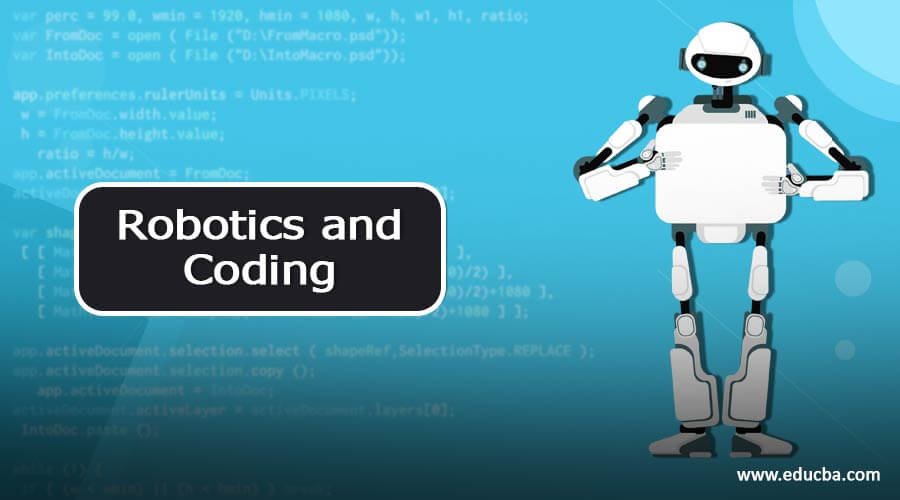Updated March 13, 2023

Definition of Robotics and Coding
Coding is a set of instructions that a robot can interpret and follow. Robotics is the application of electronics, mechanics, and programming tools to program robots to do certain tasks. Robots are capable of executing things that humans are unable to. In robotics, both block-based and text-based coding is utilized. Coding is the method of interacting with computers.
What is Robotics and Coding?
Coding is simply the implementation of an algorithm in a programming language (such as C++, Python, or Java). It is the translation of logic into real code that can be read by humans and machines. Because it is a simple technique to teach STEM in schools, coding is becoming increasingly popular. Robotics allows learners to witness their thoughts in action as they go through trial and error until the mission is completed and the robot’s motions are executed as intended. For novices in robotics programming, one should have a fundamental understanding of two things:
We’ll employ several trigonometric functions and vectors in math.
We’ll utilize basic Python libraries and functions because Python is one of the more popular basic robot programming languages. The software that creates the control signals (the “controller”) in real-world robots must operate at a fast speed and do sophisticated calculations. This has an impact on the robot programming languages that should be used: C++ is typically used in these situations, however, Python offers a suitable balance in execution speed and simplicity of development and testing in smaller robotics systems.
Robots can be virtual machines or hands that weld vehicles, but they can also be any machine that employs sensors to acquire data and produce outputs such as mobility, illumination, heat, and so on. We have constructed a robot, for example, if we create a basic gadget that watered the plants whenever a sensor placed in the soil indicates the soil is dry.
Head to Head Comparison Between Robotics and Coding (Infographics)
Below are the top 7 differences between Robotics and Coding:
Key Differences Between Robotics and Coding
| Coding | Robotics | |
| Definition | Coding is a set of instructions that must be followed. A code can be written in a variety of languages for a variety of devices and applications. | The fundamental aspect of robotics is that the robot would give lots of real-time, visible feedback on the work. |
| Programming/skills | Block-based coding. We use our coding talents in our microwaves, cars, phones, television, and bank card. | Robotics is primarily based on python and c++. Microcontrollers are introduced here. And includes coding and Engineering concept. |
| Requirements | Code Cards with good coding tutorials and freeware software for block-based coding. | Needs Basic electrical and mechanical requirements |
| Inputs /outputs | Algorithms | The inputs are robot sensors, and the outputs are signals to motors and other devices.
|
| Debugging | Errors are “hard” failures in general programming, meaning they happen regularly the code is run. | Here are the bugs that can’t be reproduced. For example, the robot may drop a component because the gripping force was insufficient. |
| Problem-solving | Students must be able to solve problems, work alone and collaboratively, and demonstrate initiative, organization, and accountability while coding. | The coding of robots necessitates logical reasoning; learners must be able to design step-by-step sequences to achieve the desired result. |
| Example/ technologies | Used in all technologies and real-life. Coding and building robots is a fun experience that can be easily integrated into any curriculum area thanks to freely available and frequently free technologies. | Edison an example of a robotics toy has Drag-and-drop programming with tremendous functionality and versatility, ideal for learning the principles of computer science. |
Both the Arduino and the Raspberry Pi are excellent choices for robotics projects.
Conclusion
Students will not only connect with technology through the study of coding, but they will also be able to build it (games, apps) and understand the machine’s language. Considering the differences between coding and robotics, on the other hand, can make it easier to establish the learners’ goals and develop another more productive learning environment. Robotics and coding, possibly the most appropriate implementation of STEM, give learners with hands-on and creative chances to invent, solve problems, and create.
Recommended Articles
This is a guide to Robotics and Coding. Here we discuss key differences with infographics and comparison table, respectively. You may also have a look at the following articles to learn more –


